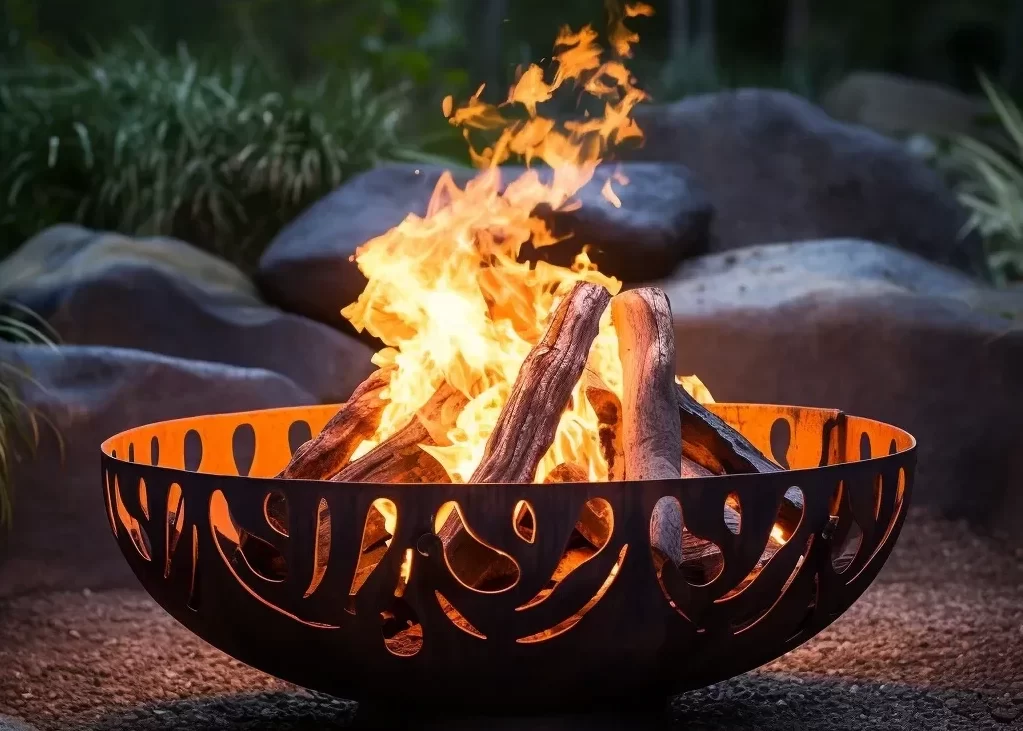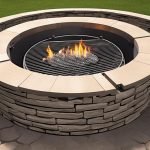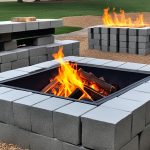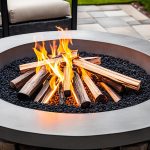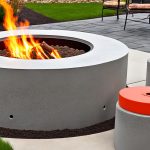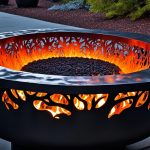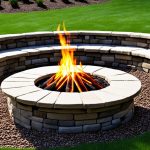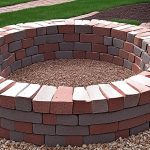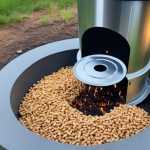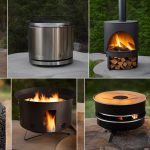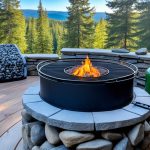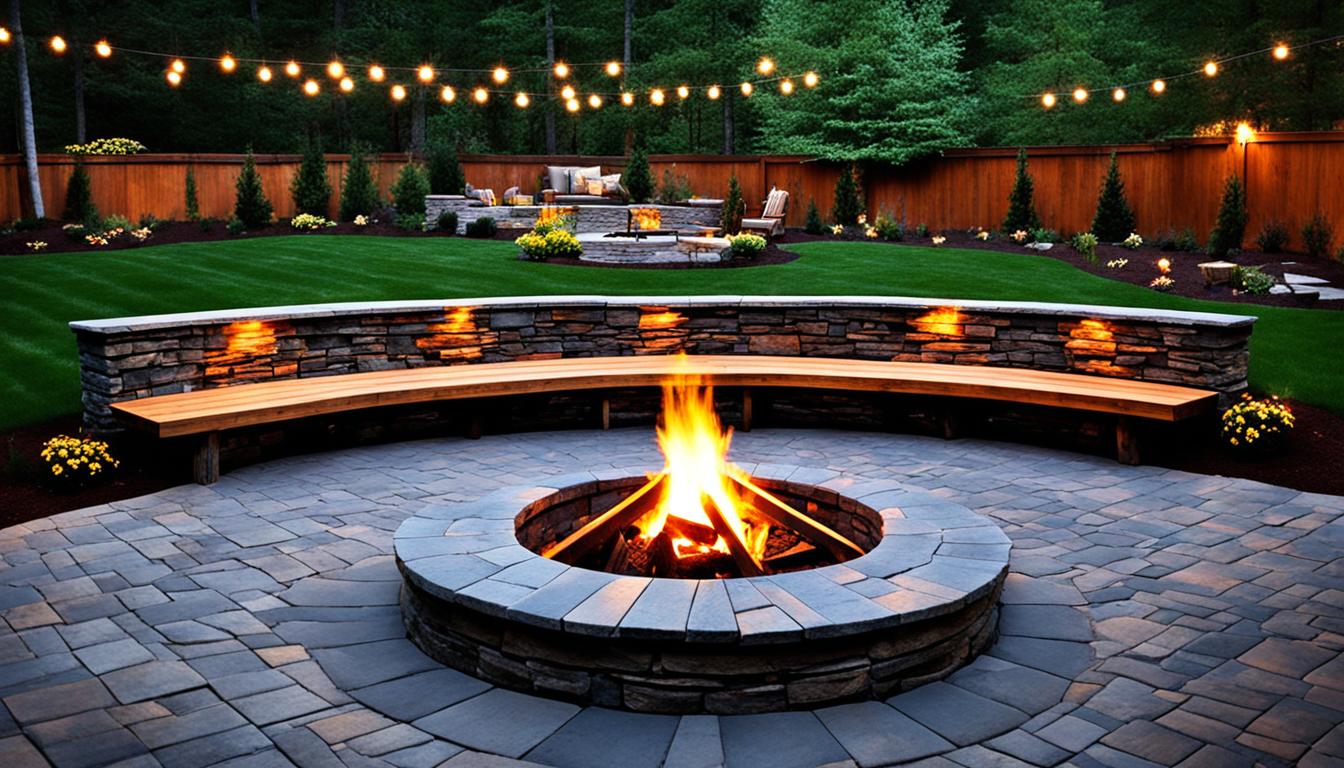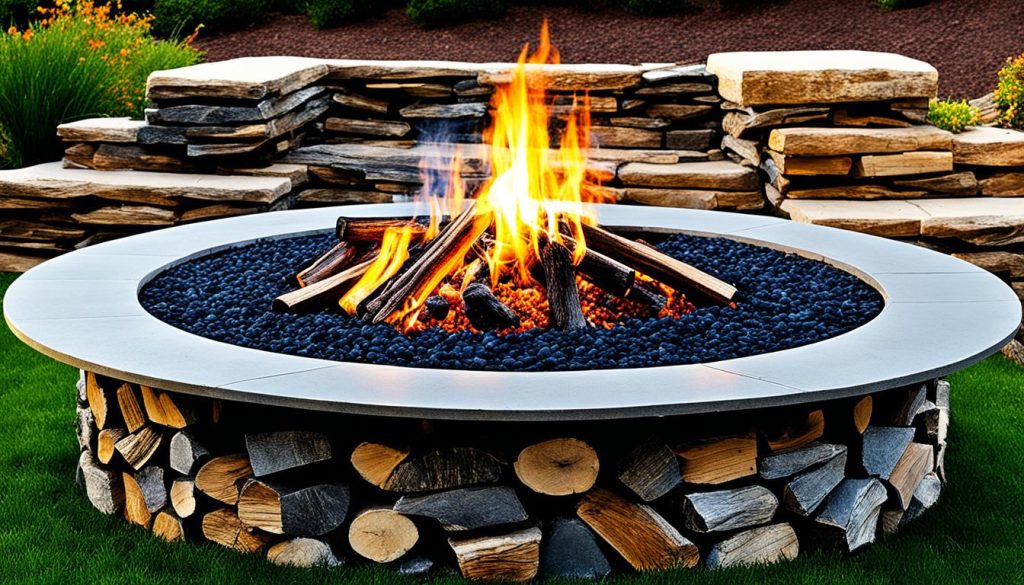
When it comes to creating a cozy and inviting outdoor space, few features can rival the charm and allure of a fire pit. Not only do fire pits provide warmth and ambiance, but they also serve as a gathering place for friends and family to enjoy the outdoors. However, when choosing between a gas fire pit and a wood fire pit, there are important factors to consider. Which option offers the most benefits? Which one is right for your outdoor living space?
Fundamental Difference Between a Gas and Wood Burning Fire Pit
When it comes to choosing the perfect fire pit for your outdoor space, understanding the fundamental differences between a gas fire pit and a wood burning fire pit is essential. The primary distinction lies in their fuel sources and operational mechanisms.
Fuel Source
A gas fire pit is fueled by either liquid propane or natural gas, while a wood burning fire pit relies on traditional wood sticks and logs as its fuel source. Gas fire pits offer the convenience of readily available fuels, while wood fire pits provide a more traditional and rustic experience.
Operational Mechanism
Operating a gas fire pit is incredibly simple. With just a switch or knob, you can easily ignite and control the flame intensity. On the other hand, wood fire pits require a bit more effort to get started and maintain the fire. You’ll need to gather firewood, arrange it properly, and constantly tend to the fire to keep it burning.
Factors to Consider When Choosing a Fire Pit
Choosing the right fire pit for your outdoor space involves several important factors. Consider the following key points when making your decision:
- Space: Evaluate the space available in your backyard or patio area. Gas fire pits and wood fire pits come in various sizes, so choose one that fits comfortably in your desired location.
- Location: Determine the best location for your fire pit. Gas fire pits require access to a natural gas line or a propane tank, so consider proximity to these fuel sources. Wood fire pits offer more flexibility in terms of location, as they can be placed further away from fuel connections.
- Intended Use: Think about how you plan to use your fire pit. Will it be primarily for ambiance and warmth, or do you want to use it for cooking as well? Consider whether you need additional features like grilling grates or rotisseries.
- Budget: Set a budget for your fire pit purchase. Gas fire pits generally have higher upfront costs due to installation requirements, while wood fire pits tend to have lower initial costs. Keep in mind that ongoing costs for firewood or propane should also be factored into your budget.
- Local Laws: Research and comply with local laws and regulations regarding fire pits. Some areas have restrictions on the use of outdoor fire features, including requirements for distance from structures and guidelines for smoke emissions. Ensure your chosen fire pit meets all necessary legal and safety standards.
Visualizing the Factors to Consider
Here’s a visual representation of the factors to consider when choosing between a gas fire pit and a wood fire pit:
| Factors | Gas Fire Pit | Wood Fire Pit |
|---|---|---|
| Space | Requires less space due to compact design | Available in various sizes, offering flexibility |
| Location | Natural gas line or propane tank access required | Can be placed further away from fuel connections |
| Intended Use | Primarily for ambiance and warmth; limited cooking capabilities | Offers a wider range of cooking options |
| Budget | Higher upfront costs; ongoing fuel expenses | Lower initial costs; firewood expenses |
| Local Laws | Compliance with regulations and safety standards required | Compliance with regulations and safety standards required |
Considering these factors will help you make an informed decision and choose the fire pit that best suits your needs, space, and budget. Always prioritize safety and local regulations to ensure a hassle-free and enjoyable experience with your fire pit.
Pros and Cons of Gas Fire Pits
Gas fire pits are a popular choice for outdoor heating and add a touch of elegance to any backyard or patio. They offer several advantages, but it’s important to consider the pros and cons before making a decision.
Pros of Gas Fire Pits
- Convenience and Ease of Use: Gas fire pits provide convenient operation with a simple switch or knob. There’s no need to gather firewood or clean up ashes, making them extremely easy to use.
- Low Maintenance: Compared to wood burning fire pits, gas fire pits require minimal maintenance. There’s no need to constantly monitor the fire or add fuel, making them hassle-free.
- Smoke-Free Operation: Gas fire pits offer a smoke-free experience, allowing you and your guests to enjoy the warmth and ambiance without unpleasant smoke or fumes.
- Eco-Friendly: Gas fire pits are considered more eco-friendly than wood burning fire pits. They produce fewer emissions, contributing to improved air quality and reduced environmental impact.
Cons of Gas Fire Pits
- Installation Cost: Installing a gas fire pit can be more expensive and complicated compared to wood burning fire pits. Professional installation may be required to ensure proper connection and safety.
- Limited Cooking Capabilities: While gas fire pits can provide a great ambiance for outdoor gatherings, they may have limited cooking capabilities compared to wood burning fire pits.
When considering a gas fire pit, weigh these pros and cons against your personal needs and preferences. Gas fire pits offer a convenient and low-maintenance outdoor heating option, allowing you to enjoy your outdoor space without the hassle of wood handling and maintenance. However, the installation cost and limited cooking capabilities should be taken into account before making a final decision.
Testimonial:
“I absolutely love my gas fire pit. It’s so easy to use, and I don’t have to deal with the mess and smoke of a wood fire pit. It’s the perfect addition to my backyard for cozy evenings with family and friends.” – Sarah, Happy Gas Fire Pit Owner
Pros and Cons of Wood Burning Fire Pits
Wood burning fire pits offer a unique and traditional ambiance, creating a cozy atmosphere in your outdoor space. They are known for their greater heat output, providing warmth on chilly nights and extending the usability of your outdoor living area. The crackling sound and distinct aroma of burning wood add to the overall experience, enhancing the sensory enjoyment of gathering around a fire.
However, wood fire pits do have their drawbacks and considerations to keep in mind:
- Effort to Start and Maintain: Unlike gas fire pits that can be easily ignited with a switch or knob, wood fire pits require more effort to start and maintain the fire. You’ll need to gather and arrange wood sticks and logs, ensuring proper airflow and taking precautions to prevent sparks and embers from escaping.
- Smoke and Environmental Impact: Wood burning fire pits produce smoke, which can cause discomfort for individuals with respiratory conditions and may contribute to air pollution. The environmental impact of burning wood should also be considered, as it can contribute to deforestation and increase carbon emissions.
- Regular Maintenance: Wood fire pits require regular maintenance to keep them in optimal condition. This includes removing ash and debris after each use, inspecting and cleaning the fire pit, and ensuring proper ventilation. Failure to maintain a wood fire pit can compromise its safety and longevity.
- Properly Extinguishing the Fire: It’s crucial to properly extinguish the fire in a wood burning fire pit to prevent accidents and minimize the risk of fire spreading. This involves ensuring the fire has completely burned out, dousing it with water, and monitoring the area until it is cool to the touch.
Despite these considerations, many people still prefer wood burning fire pits for their authentic appeal, nostalgia, and the primal connection to nature they offer. The pros and cons of wood fire pits should be carefully weighed against your personal preferences and lifestyle before making a decision.
Wood burning fire pits have their own unique charm and considerations. While they require more effort and maintenance, they provide a traditional ambiance, greater heat output, and an authentic outdoor experience. By understanding and addressing the cons associated with wood fire pits, you can enjoy the benefits they bring to your outdoor living space.
Gas vs. Wood Fire Pit Aesthetic Appeal and Customizations
When it comes to choosing a fire pit for your outdoor living space, both gas fire pits and wood fire pits offer a range of aesthetic appeal and customizations that can elevate your backyard experience. From design styles to materials and even the choice between portable or built-in options, there are plenty of ways to personalize your fire pit to suit your style and preferences.
Design Styles and Materials
Both gas fire pits and wood fire pits come in various design styles, allowing you to find the perfect match for your outdoor space. Whether you prefer a sleek and modern look or a rustic and traditional feel, there is a design style to suit every taste. Popular options include:
- Contemporary designs with clean lines and minimalist aesthetics
- Traditional designs with intricate details and decorative elements
- Rustic designs that mimic the charm of a campfire
When it comes to materials, the choices are endless. Common options for both gas fire pits and wood fire pits include stone, metal, and concrete. Each material offers its own unique look and durability, allowing you to create a fire pit that perfectly complements your outdoor decor.
Portable vs. Built-in
Another factor to consider when customizing your fire pit is whether you prefer a portable or built-in option. Portable fire pits are versatile and can be easily moved around your outdoor space or even taken on camping trips. They are typically smaller and lighter, making them ideal for smaller patios or decks.
On the other hand, built-in fire pits are a more permanent feature and can be seamlessly integrated into your outdoor landscape or patio design. They often provide a more polished and cohesive look, creating a focal point in your outdoor space. Built-in fire pits are typically larger and can accommodate more people around the fire.
Customizations and Enhancements
Both gas fire pits and wood fire pits offer opportunities for customization and enhancements. Some popular options include:
- Addition of fire glass or lava rocks to enhance the visual appeal
- Incorporation of seating options, such as built-in benches or outdoor chairs
- Integration of cooking features, such as grills or rotisseries, for outdoor entertaining
Customizing your fire pit allows you to create a unique and inviting space that reflects your personal style and enhances your outdoor living experience.
Gas vs. Wood Fire Pit Aesthetic Appeal and Customizations
| Aspect | Gas Fire Pit | Wood Fire Pit |
|---|---|---|
| Design Styles | Contemporary, traditional, rustic | Contemporary, traditional, rustic |
| Materials | Stone, metal, concrete | Stone, metal, concrete |
| Portability | Portable | Portable |
| Integration | Built-in | Built-in |
| Customizations | Fire glass, seating options, cooking features | Fire glass, seating options, cooking features |
Overall, both gas fire pits and wood fire pits offer a wide range of design options and customizations to match your taste and enhance the ambiance of your outdoor space. By considering the design styles, materials, portability, and integration options, you can create a fire pit that becomes a stunning centerpiece for your backyard gatherings.
Installation, Maintenance, and Durability
When it comes to installation, gas fire pits and wood fire pits have different requirements. Gas fire pits need professional installation of gas lines to ensure safety and proper functionality. This can involve hiring a certified technician to run gas lines from the source to the fire pit. On the other hand, wood fire pits can be DIY projects, making them a more accessible option for those who enjoy hands-on installations.
In terms of maintenance, both gas fire pits and wood fire pits require regular upkeep to ensure optimal performance and safety. Gas fire pits tend to be lower maintenance, as they do not produce ashes or require wood replenishment. Cleaning the burners and inspecting the gas connections periodically are the main maintenance tasks for gas fire pits. Wood fire pits, on the other hand, require regular cleaning of ashes, proper storage of firewood to prevent moisture and pests, and occasional inspections for any signs of wear or damage.
“Gas fire pits offer the convenience of no ashes and low maintenance, while wood fire pits require regular cleaning and maintenance to keep them in top condition.”
When it comes to durability, the lifespan of a fire pit depends on the quality of materials used and how well it is maintained. Both gas fire pits and wood fire pits can last for a long time with proper care. Gas fire pits made with high-quality materials such as stainless steel or cast iron are known for their durability. Wood fire pits, on the other hand, may require occasional repairs or replacements due to wear and tear from the intense heat. Regular maintenance and avoiding exposure to extreme weather conditions can extend the lifespan of both types of fire pits.
| Installation | Maintenance | Durability | |
|---|---|---|---|
| Gas Fire Pit | Requires professional installation of gas lines | Lower maintenance, periodic inspection of gas connections and burners | Durable with high-quality materials |
| Wood Fire Pit | DIY installation | Regular cleaning of ashes, maintenance of firewood, occasional inspections | May require occasional repairs or replacements |
Environmental Impact and Sustainability
When considering the environmental impact and sustainability of fire pits, it’s important to compare the emissions and energy efficiency of gas fire pits and wood burning fire pits. While both options provide warmth and atmosphere, they differ in their effects on air quality, natural resources, and ecosystems.
Gas fire pits are known for their lower emissions and higher energy efficiency. They utilize clean-burning fuels like natural gas or liquid propane, resulting in reduced air pollution and smog formation. This not only benefits the immediate surroundings, but it also contributes to global efforts in improving air quality. Additionally, gas fire pits have higher energy efficiency, allowing you to maximize heat output while minimizing fuel consumption.
On the other hand, wood burning fire pits can contribute to air quality concerns due to the combustion of wood logs and particles released into the atmosphere. The smoke from wood fires contains pollutants such as particulate matter and volatile organic compounds (VOCs), which can have adverse health effects and contribute to smog formation. It’s important to note that the use of dry, seasoned wood and proper ventilation can minimize these emissions.
To address sustainability concerns with wood fire pits, it’s essential to explore sustainable fuel options. This includes using sustainably sourced firewood and considering alternative biomass fuels, such as wood pellets or briquettes made from recycled materials. These options reduce the environmental impact by promoting responsible forestry practices and minimizing waste.
When considering the impact on ecosystems, both types of fire pits can have consequences. Wood fire pits rely on the consumption of wood, which can contribute to deforestation and habitat loss if not sourced sustainably. Additionally, the extraction and transportation of wood can have ecological implications. Gas fire pits, although cleaner in terms of emissions, contribute to climate change through carbon emissions, which can impact ecosystems on a global scale.
Eco-Friendly Tips:
- Opt for a gas fire pit, if possible, to minimize emissions and maximize energy efficiency.
- If using a wood burning fire pit, choose sustainably sourced firewood and consider alternative biomass fuels.
- Regularly inspect and clean your fire pit to ensure optimal performance and minimize emissions.
- Properly extinguish the fire and dispose of ashes responsibly to prevent environmental hazards.
- Consider offsetting the carbon emissions produced by gas fire pits through carbon offset programs or initiatives.
Awareness of the environmental impact and sustainability of fire pits is crucial for responsible enjoyment of outdoor living. By making informed choices and adopting eco-friendly practices, you can minimize your carbon footprint and contribute to a more sustainable future.
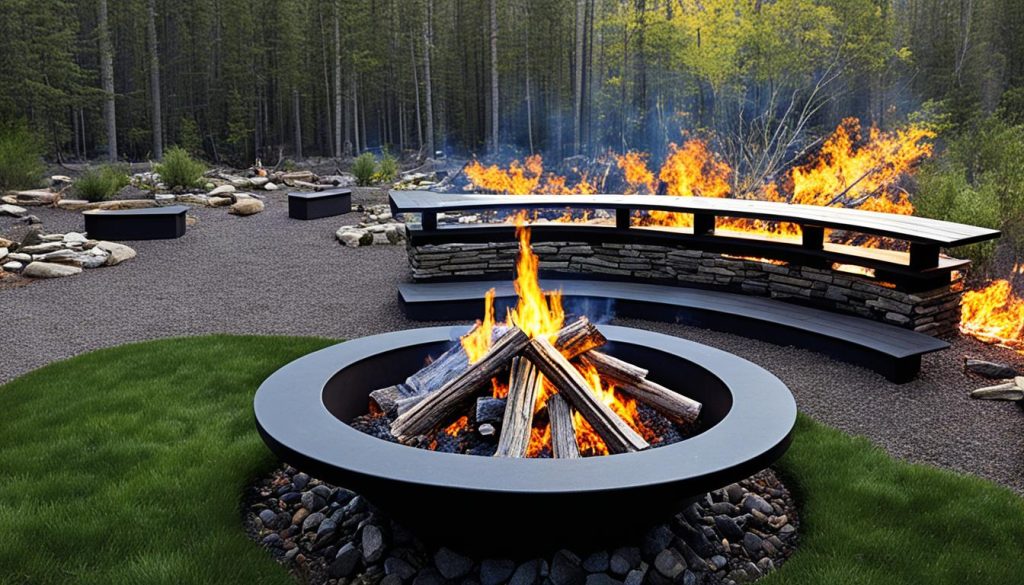
Costs, Return on Investment, and Resale Value
When considering the costs, return on investment, and resale value of fire pits, there are some important factors to keep in mind. Let’s take a closer look at how gas fire pits and wood fire pits differ in these aspects.
The Costs of Gas Fire Pits
Gas fire pits generally have higher upfront costs compared to wood fire pits. The installation requirements for a gas fire pit, such as professional gas line installation and connection to a natural gas source or propane tank, can contribute to the initial expense. However, it’s worth noting that gas fire pits are often considered a valuable addition to outdoor living spaces, which can increase the overall resale value of a home, making it a worthwhile investment in the long run.
The Costs of Wood Fire Pits
On the other hand, wood fire pits tend to have lower initial costs. They typically don’t require professional installation and can be a more budget-friendly option. However, it’s important to consider ongoing costs for firewood. The expenses associated with purchasing firewood can add up over time, especially if the fire pit is used frequently. Additionally, it’s worth considering the effort and time required to gather, store, and maintain a supply of firewood.
Return on Investment and Resale Value
While the initial costs of a fire pit are important to consider, it’s also essential to think about the long-term value and return on investment. Gas fire pits are often seen as attractive features that can enhance the appeal and functionality of outdoor spaces, which can increase the resale value of a property. Potential buyers may be willing to pay a premium for homes with well-designed gas fire pits, considering them as desirable outdoor living amenities. In contrast, wood fire pits, while they may have lower upfront costs, may not offer the same level of appeal or contribute as significantly to the overall value and marketability of a home.
In summary, while gas fire pits may come with higher upfront costs, they have the potential to offer a greater return on investment and increase the resale value of a home. On the other hand, wood fire pits offer a budget-friendly option, but ongoing costs for firewood should be considered. Ultimately, the choice of fire pit will depend on your budget, the desired return on investment, and your preferences for outdoor living.
| Gas Fire Pit | Wood Fire Pit | |
|---|---|---|
| Initial Costs | Higher upfront costs due to installation requirements | Lower initial costs |
| Ongoing Costs | Minimal ongoing costs beyond fuel expenses | Costs for firewood |
| Return on Investment | Potential to increase the resale value of the home | May not significantly impact the resale value |
Safety and Permits
When it comes to enjoying the warmth and ambiance of a fire pit, safety should always be a top priority. Whether you opt for a gas fire pit or a wood fire pit, there are important considerations to keep in mind. Proper maintenance and adherence to local regulations can ensure a safe outdoor experience.
Gas Fire Pit Safety
A gas fire pit requires regular inspection for leaks to ensure safe operation. It is essential to check the gas connections and fittings for any signs of damage or wear. If you detect a gas leak or suspect a problem with the fire pit, it’s crucial to contact a professional to address the issue promptly.
Additionally, proper maintenance of the gas fire pit is vital to ensure its longevity and safety. Regular cleaning of the burner and control mechanisms can prevent buildup and blockages that may affect the fire pit’s performance. Following the manufacturer’s guidelines for maintenance and usage can help prevent accidents and promote safe operation.
Wood Fire Pit Safety
Wood fire pits require extra caution to minimize fire risks. The use of dry and seasoned firewood is essential to prevent excessive smoke and unpredictable flames. Avoid burning treated wood, as it can release harmful chemicals and pollutants into the air.
When using a wood fire pit, it’s crucial to follow these safety guidelines:
- Keep a safe distance between the fire pit and any flammable objects, such as plants, furniture, or structures.
- Never leave the fire pit unattended, especially when children or pets are present.
- Ensure the fire is fully extinguished before leaving the area or going to bed.
- Have a fire extinguisher or fire blanket nearby in case of emergencies.
Permits and Local Regulations
Before purchasing and installing a fire pit, it’s important to check with local authorities regarding permits and regulations. Some municipalities may have specific rules regarding fire pit placement, fuel types, and safety features. By complying with these regulations, you can avoid potential fines and ensure the safety of yourself and your neighbors.
It’s also essential to consider the proximity of neighbors and the potential impact on air quality. Being considerate of others and the environment can help foster positive relationships and a peaceful neighborhood.
Remember, while fire pits can provide warmth and create a cozy atmosphere, they should always be used responsibly and with safety in mind.
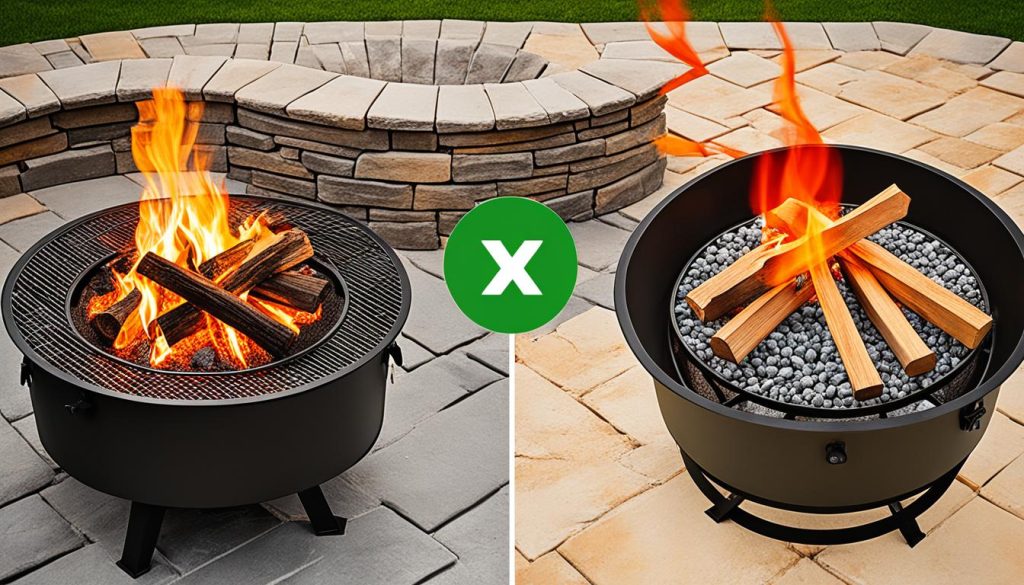
Conclusion
When it comes to choosing a fire pit for your backyard, the decision between a gas fire pit and a wood fire pit ultimately boils down to personal preference and specific needs. Gas fire pits offer the advantages of convenience, low maintenance, and a sleek, modern appeal. On the other hand, wood fire pits provide the charm of a traditional ambiance and produce a greater amount of heat.
Before making a decision, it’s important to consider various factors such as the fuel source, operational mechanism, appearance, available space and location, intended use, budget, and local regulations. Gas fire pits require access to either a natural gas line or a propane tank, while wood fire pits offer more flexibility in terms of placement. Additionally, researching and complying with local laws and regulations regarding fire pit usage is essential.
Both gas fire pits and wood fire pits can enhance outdoor living by creating a captivating centerpiece in your backyard. Whether you prefer the convenience and modern aesthetics of a gas fire pit or the nostalgic charm and warmth of a wood fire pit, either option will undoubtedly add a touch of magic to your outdoor space.
Recommended
- Buy Solo Stove: Find Your the Best Retailer OnlineMaster How to Use Solo Stove – Tips & TricksUnderstanding How Solo Stove Works | Eco-Friendly Tech

Otis, 52, embodies a lifetime of adventure, from the rugged hills of the USA to serene camping spots worldwide. His passion for the outdoors isn’t just a hobby; it’s a way of life that includes hiking, camping, and exploring the unknown. With decades of experiences under his belt, Otis shares his adventures and lessons learned through Natural Fire Pit. Beyond fire pits, his expertise in outdoor living, from setting up the perfect tent to finding off-the-beaten-path travel destinations, guides fellow enthusiasts. Follow Otis’s journey for a deeper connection with nature.
